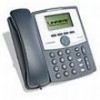Linksys SPA922 Cisco SPA9000 Voice System Web-UI Based Product Installation an - Page 101
Configuring Phone Service and Voice Mail, DID Number, Extension Number
 |
UPC - 745883570836
View all Linksys SPA922 manuals
Add to My Manuals
Save this manual to your list of manuals |
Page 101 highlights
Configuring Phone Service and Voice Mail Configuring Inbound Call Routing 5 • - The extension will not be alerted when there is an incoming call to the DID number. However, the DID number will be used as the local user-ID in outbound SIP requests, along with the display-name of the extension. • DIDn#: DID number, matching the format of the number signaled in the SIP trunk • Extn#: Target extension number or aa for Auto Attendant • Default route: The default route (extension, hunt group or Auto Attendant) to be used in case the incoming target number does not match any of the DID numbers in the contact list with the format described in the sections above. • Call forward: Optionally, add call forward information to the Contact List to specify how unanswered calls are handled. NOTE It is useful to add call forward information to ensure that calls are answered when the designated phone is unstaffed, as may be the case during lunch time or after hours. If the call is not answered within a specified time, it is routed to another phone or to the Auto Attendant. SYNTAX: :+,cfwd= | :+,cfwd= | :+,cfwd= EXAMPLE: 4085555550:aa | 4085555551:+101,cfwd=aa | 4085555552:+102 | 4085555553:+103 | 4085555554:+104 | 4085555650:+500 STEP 1 Plan the DID-to-extension mapping. Refer to the following example. DID Number Extension Number 408-555-5550 aa 408-555-5551 101 408-555-5552 102 408-555-5553 103 408-555-5554 104 408-555-5650 500 User Auto Attendant User 1 User 2 User 3 User 4 Support (hunt) group SPA9000 Voice System Installation and Configuration Guide for Web UI 99















